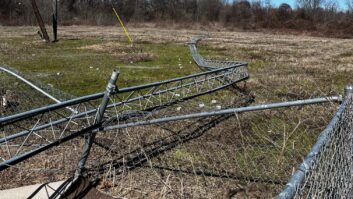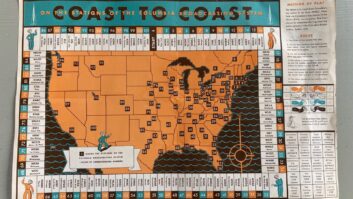Parked behind a wide floor-to-ceiling window on the second floor of a new $20 million building on Manhattan’s once wild and wooly “Alphabet City,” the Lower Eastside Girls Club’s new WGRL Internet broadcast studio is helping to revitalize radio’s role in young people’s lives.
BUILDING BACKGROUND
In a move designed to empower, inspire and educate young women to achieve their creative potential, LESGC co-founder Lyn Pentecost and a diverse group of community, grassroots and financial supporters created the LESGC in 1996.
Pentecost and her associates built a unique and formidable organization. In the process they not only raised consciousness, they also raised the funds for a sustainably built 12-story mixed usage building at 101 Avenue D in the heart of NYC’s storied Lower East Side. They broke ground for the project in 2010 and completed construction in 2013.

Featuring an array of educational options — ranging from a digital photography/computer graphics/3D-printing lab, to hands-on BioBus labs, small business training and incubator space (commercial kitchen, bakery, gift shop, cafe) and a 64-seat planetarium — the LESGC stretches across three floors and 30,000 square feet.
Incongruously capping this eclectic assemblage of educational and career training options for low-income teens is a classic Airstream Trailer, circa 1958.
Far from ornamental, the Airstream houses a professional-level streaming, recording and teaching studio. A pet project of TV editor/musician/LESGC Director of Technology Dave Pentecost, the trailer was purchased by the Pentecosts as a sidecar to their upstate New York cabin in the Adirondack Mountains. When the LESGC building became a reality, they decided their Airstream could serve a better purpose in the community as a sound studio, and they brought it to Manhattan.
TRAILER MEETS BIG CITY
I’d met Dave years earlier and was pleased to reconnect with him in 2010 when he called with one of the most unusual project requests we’ve ever had. Was it possible, he wanted to know, to create a viable recording studio within the confines of a 140-square-foot Airstream Trailer?
The obvious answer is yes, although the geometry, the equipment selection and the acoustic considerations did present us with significant design constraints.
The Walters Storyk Design Group has been around for more than 45 years. We’ve designed TV, broadcast and music recording studios all over the world in such disparate environments as a basement (Electric Lady), a duplex penthouse (Jungle City) and a warehouse building (Circo Beat Studios), but we’d never been asked to build a broadcast studio in an Airstream Trailer.

As a visiting professor of acoustics and studio design for the Berklee College of Music and other schools, I have an abiding interest in educating young people. Dave Pentecost’s compelling challenge was an opportunity to help create a useful studio with the potential to turn a new generation of bright young women into creative broadcasters. This need was particularly important because, strangely enough, New York City has few, if any, distaff alternatives to the city’s various Boys Club organizations.
Bringing the Airstream to New York and hoisting it into its new home on the second floor of a 12-story construction site was a project in itself.
Once the Airstream was gutted down to its aerodynamic shell, WSDG Project Manager Matt Ballos and I began working with our design team to maximize the interior and develop an acoustic treatment program that would ready the studio and its compact control room for 5.1 surround recording and mixing assignments. We also compiled a gear wish list that would facilitate the planned studio’s missions, including recording, mixing, streaming and instructing.
MULTIFUNCTIONAL SPACE
The Airstream studio comprises a live room for recording and broadcasts and a control room to produce and mix programming for the club’s new WGRL Internet station. It is also used to create sound tracks for student videos and for the LESGC Planetarium’s educational presentations.
Capable of accommodating up to three students and an instructor in the control room plus four additional artists/interview subjects in the front booth area, the Airstream, visible from the street, resides in the second floor’s stage-equipped community room, which also serves as a combination classroom and performance venue.
Though compact, the Airstream control room is 5.1 surround sound-ready and features an array of professional gear that includes an Avid C/24 mixing console, Genelec Speakers, outboard processing technology from Manley, API, Neve, Universal Audio, SSL, etc., and microphones from Neumann, Royer, Shure and Sennheiser.

This serious, professional-level studio provides LESGC members with a real-world, hands-on recording experience and full capability to compose, produce, record and mix an entire music or streaming production from A to Z.
Since its official opening in December, WGRL has produced, recorded and streamed hundreds of interviews, performances and remote programs that run the content gamut from covering a politically inspired art event in the Andaz Hotel on New York’s Fifth Avenue to sharing a dim sum meal at Joe’s Shanghai Restaurant in Chinatown, and an interview with two activists from The Grail, a nongovernmental organization focused on promoting women’s rights, health, education and international solidarity.
MAKING WAVES
In November, the LESGC hosted Girls Making Waves, a music and technology conference, in partnership with the Willie Mae Rock Camp for Girls. The free event included 40 girls ages 11–18 and featured workshops on coding technology, radio production, beat-making and sound design. The camp also presented a panel of women from the fields of music and technology.
The Lower Eastside Girls Club and Willie Mae Rock Camp are partnering on a 10-month sound design program, “Making Waves: The Science of Sound,” that teaches girls about digital sound design, multimedia production and diverse careers in music technology. Girls also have the opportunity to meet professional women at the forefront of new technologies in the music industry.

For samples of WGRL programming visit https://soundcloud.com/wgrlnyc/sets.
Lyn Pentecost reports that Odetta Hartman and Kiya Vega, the women who teach the LESGC WGRL Radio and Beats by Girls classes, are making real progress with the studio.
Although they’re still teaching themselves to take full advantage of the technology, and while their creative programming is still getting off the ground, the instructors are deeply impressed with the level of enthusiasm from the girls and young women, aged 8–23, with whom they’ve been working. LESGC members are proving themselves adept and industrious young broadcasters.
According to Pentecost, their funky Airstream has been graced by visits from some pretty cool supporters and well-wishers. Since the studio was completed, they’ve welcomed a number of artists, including former Sex Pistol bass guitarist Glen Mat-lock and recording star Regina Spektor, who came by to say “hi” and drop a few beats with the girls who are learning Ableton Push Controller. Actress Heather Graham, TV personality Tyra Banks, DJ/performer Donna “D” Cruz and Tommy Boy Records founder Tom Silverman have toured the building and the Airstream. Tom Petty sent the LESGC a few guitars, and the girls have also had the opportunity to sing and record with Moby, Joan Baez and Roseanne Cash in the on-site planetarium.
LESGC instructors are teaching the girls how to do professional interviews, and this summer they will be ready to launch a weekly series of podcasts.
UNIQUE FEATURE SET

Drawing on her undergraduate degrees in architecture and design from the Cooper Union, where she studied under John Hejduk, and from her two years as an apprentice to architect Paolo Soleri, Pentecost took the design lead on the Girls Club project, working with the architects of record.
As a result, The Lower Eastside Girls Club has features not before seen in a youth center. In addition to the full-dome planetarium and Airstream studio, the building showcases a dramatic interior proscenium staircase in the academic center; artist-commissioned art bathrooms; an art-filled café adjacent to a courtyard with a Kiki Smith fountain; high ceilings, maximum natural light, a sedum green roof; and strategic use of whimsical neon to send a welcoming message in a low-income community where most architectural design falls short.
WSDG was pleased to be involved with the LESGC Airstream Studio project. It may not be entirely coincidental that we are currently engaged in two contrasting public radio station upgrade projects on the West Coast. Whether in an Airstream Trailer or a brand new state-of-the-art broadcast complex, radio stations remain an important aspect of the WSDG Active Project list.










